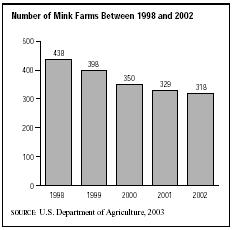SIC 0971
HUNTING AND TRAPPING AND GAME PROPAGATION
This category includes establishments primarily engaged in commercial hunting and trapping, or in the operation of game preserves.
NAICS Code(s)
114210 (Hunting and Trapping)

Despite a weak U.S. economy, fur sales in 2002 jumped 13.2 percent to $1.7 billion due to increased sales in fur and fur-trimmed products made of sheared mink and beaver fur. Roughly 45 percent of fur retailers saw an upswing in store traffic in 2002.
Hunting and trapping are among the oldest industries in the United States. Trading in beaver pelts played a role in the western expansion of the United States. As areas became over exploited, the commercial trade moved further and further west. During the nineteenth century, there were few ordinances governing the taking of furbearing animals. As a result some species were threatened. One of the first animal management regulations regarded fur seals. Under the terms of the Alaska Convention of 1911, Japan, Russia, Canada, and the United States agreed to limit catches according to governmental rules. The resulting regulations enabled seal populations to recover and sustain themselves.
The twentieth century brought other regulations to the industry. Seasons for taking animals were open or closed based on the management needs of specific populations. Many jurisdictions instituted laws requiring trappers to check their traps at frequent intervals, usually every 24 hours. The Endangered Species Confiscation Act of 1969 listed animals "threatened with world-wide extinction" and prohibited trading in them.
During the 1960s and 1970s, the United States saw growing antagonism between members of the animal rights movement and trappers and hunters. Animal rights activists aimed their efforts at reducing demand for fur products, which resulted in price declines. Trappers and hunters responded by developing programs in conjunction with governmental regulators to manage populations of wild animal stocks at sustainable levels and to seek more humane trapping techniques.
There are 23 fur-bearing species in the United States spread among all the states, except Hawaii. Of those 23, eight make up about 92 percent of the annual fur harvest. The species are, in descending order: muskrat, raccoon, opossum, nutria, beaver, coyote, mink, and gray and red fox (gray fox and red fox are often counted together).
Today, the U.S. fur industry is divided into two segments: "wild caught" and "ranch farmed." Wild-caught pelts account for the majority of U.S. fur production, but ranch-farmed pelts are worth much more and account for a larger percentage of annual sales. In 2004 roughly 200,000 trappers were registered in the United States. Mink pelt production in the United States in 2002 totaled 2.6 million pelts, down from the 1998 number of 2.94 million pelts. Wisconsin, the major mink producing state, produced 594,700 pelts in 2001. Total mink pelts produced in 2002 were valued at $79.6 million, up from $72.9 million in 1998, but down considerably from $99.1 million in 1997. Mink farms in the United States totaled 318 in 2002. Utah operated 80 of these farms, while Wisconsin operated 69 and Minnesota operated 33. The two major American fur markets are in New York and Chicago, and there are more than 1,500 retail stores in the United States specializing in fur garments.
Most of the ranch farming in the United States involves mink, but a significant number of fox farms exist as well. A total of 20 mink farms also raised fox. Less than $100 million in mink, or 95 percent of mink produced in the United States, is exported annually, which accounts for 10 percent of the world's mink supply.
Although hunting and trapping have traditionally involved taking animals for their pelts and skins, the 1990s and 2000s saw increases in other occupations within this classification. Experienced hunters and trappers turned to work as guides for hunting parties. Some trappers focused their efforts on catching animals for research or wildlife management programs. A growing specialty was the practice of capturing wild animals in urban areas so that they could be removed to other environments. Another component of this category is the game preserve, where game populations are controlled to provide a hunting experience for visitors.
Further Reading
Fur Information Council of America. "U.S. Fur Sales Surge Ahead in 2002 for Record Sales of $1.7 Billion," September 2003. Available from http://www.fur.org/fica2003/press/pressRead.asp?pressID=14 .
U.S. Department of Agriculture. "Mink." National Agricultural Statistics Service. Washington, D.C., 15 July 2003. Available from http://usda.mannlib.cornell.edu/reports/nassr/other/zmi-bb/mink0703.txt .
Comment about this article, ask questions, or add new information about this topic: